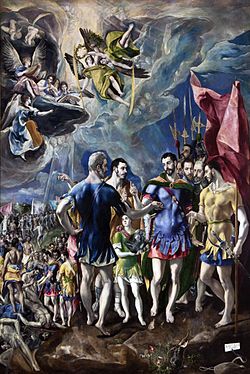Top Qs
Timeline
Chat
Perspective
July 1 (Eastern Orthodox liturgics)
From Wikipedia, the free encyclopedia
Remove ads
June 30 - Eastern Orthodox Church calendar - July 2

All fixed commemorations below are celebrated on July 14 by Old Calendar.[note 1]
For July 1st, Orthodox Churches on the Old Calendar commemorate the Saints listed on June 18.
Saints
- Holy and Wonderworking Unmercenaries Cosmas and Damian of Rome, brothers (284)[1][2][3][note 2]
- Saint Potitus od Gargara, martyr (2nd century)[4][5]
- Holy 2000 Martyrs, by the sword.[6][note 3]
- Holy 25 Martyrs in Nicomedia, by fire.[1][8]
- Saint Maurice.[9][note 4]
- Saint Shenoute, Archimandrite, Father of the Third Ecumenical Council (d. 465).
- Venerable Peter the Patrician (Peter of Constantinople), monk (854)[1][11][12]
- Venerable Basil, founder of the Monastery of the Deep Stream, Cappadocia (10th century)[1][13][note 5]
- Saint Leo the Hermit, Ascetic.[14][note 6]
Remove ads
Pre-Schism Western saints
- Saint Martin of Vienne, third Bishop of Vienne in France (c. 132)[15][note 7]
- Martyr Potitus at Naples (161)[1][17] (see also: January 13)
- Martyrs Julius and Aaron, Protomartyrs of Wales, suffered in Caerleon-on-Usk under Diocletian (304)[1][15][18][note 8]
- Saints Castus and Secundinus, much venerated in the south of Italy; they were born in Sinuessa (Mondragone) near Caserta (305)[15][19][note 9]
- Saint Domitian (c. 337-440)[15][note 10][note 11]
- Saint Theodoric (Thierry, Theodericus), Abbot of Mont d'Or near Rheims in the north of France; priest and disciple of the blessed Bishop Remigius (c. 533)[15][20][note 12]
- Saint Carilefus (Calais), a companion of St Avitus, founded the monastery of Anisole in Maine in France (c. 536)[15][21]
- Saint Gal I (Gallus of Clermont), Bishop of Clermont, uncle and teacher of St Gregory of Tours (c. 553)[1][15][16][22]
- Saint Leonorius (Léonor, Lunaire) (c. 570)[15][23][24][25][26][note 13]
- Saint Eparchius (Cybar), born in a noble family in Périgord in France, he renounced his title to become a monk at Sessac in Gaul (581)[1][15][27][note 14]
- Saint Serf (Servanus), the Apostle of West Fife in East Scotland, who reposed and was buried in Culross (c. 583)[1][15][28][29]
- Saint Veep ((Veepus, Veepy, Wimp, Wennapa), patron saint of St Veep in Cornwall (6th century)[15]
- Saint Cewydd, a saint of Anglesey in Wales and at Lancaut in Gloucestershire in England (6th century)[15]
- Saint Juthwara, sister of St. Sidwell; she was of British descent and lived in Devon in England (7th century)[15]
Remove ads
Post-Schism Orthodox saints
- Martyr Constantine of Cyprus (Constantine of Allemagne), Wonderworker, and those with him (late 12th century)[1][30][note 15]
- Venerable Leontius of Rădăuți, Bishop of Rădăuți in Moldavia (1432)[1][31]
- Saint Angelina (Branković), Despotina of Serbia (16th century)[1][32][note 16]
New martyrs and confessors
Other commemorations
Icon gallery
- Holy Wonderworking Unmercenary Physicians Cosmas and Damian at Rome (Russian icon, 15th century).
- "The Martyrdom of Saint Maurice" by El Greco, 1580-82.
- St. Angelina of Serbia, Despotina of Serbia.
- The tomb of John of Rila, near Rila Monastery.
Notes
- The notation Old Style or (OS) is sometimes used to indicate a date in the Julian Calendar (which is used by churches on the "Old Calendar").
The notation New Style or (NS), indicates a date in the Revised Julian calendar (which is used by churches on the "New Calendar"). - The Unmercenary Saints Cosmas and Damian of Rome should not be confused with the Unmercenary Saints Cosmas and Damian of Asia Minor (November 1), or the Unmercenary Saints Cosmas and Damian of Arabia (October 17).[3]
- The Venerable Basil came from Cappadocia, and lived at the time of Emperor Constantine Porphyrogenitus (901-959). He was the son of Leo the Philosopher and Zoe.
- The Synaxarion reports that he lived in the nude due to his severe asceticism, and died peacefully.
- "In England, the holy martyrs Julius and Aaron, who suffered after St. Alban, in the persecution of Diocletian. In the same country, a great number being at that time tortured in different manners and barbarously lacerated, ended their combat, and attained to the joys of the heavenly city."[16]
- Born in Rome and orphaned when young, he became a monk at Lérins in the south of France. Later he founded the monastery of Bebron, now St Rambert de Joux.
- "In the diocese of Lyons, the decease of St. Domitian, abbot, who was the first to lead there an eremitical life. After having assembled in that place many servants of God, and gained great renown for virtues and miracles, he was gathered to his fathers at an advanced age."[16]
- A son of Hoel, King of Brittany, but born in Wales. A disciple of St Illtud of Wales, he was ordained by St Dubricius, and crossed to Brittany in early life. Once in Brittany, he founded the monastery of Pontual, near Saint-Malo.
- Note, another one of these 300 Allemagne Saints, who came to Cyprus from Palestine, and lived as ascetics in various parts of the island, is: "Venerable Abbacum the Ascetic of Cyprus, Wonderworker (late 12th century)", who is commemorated on December 2.
- St. Angelina is also commemorated on December 10 with her husband St Stephen and her son St John.
Remove ads
References
Sources
Wikiwand - on
Seamless Wikipedia browsing. On steroids.
Remove ads




